电力电子技术_英文版_课件_1
电力电子技术双语课件第5-8章

5.2.2 Bridge chopper (H-bridge DC/DC converter)
5.2.3 Multi-phase multi-channel DC/DC converters
30
Power
5.2.1 A current reversible chopper
V1
E
VD2
L
V2
VD1
uo
R io M EM
Power
Can be considered as a combination of a Buck and a Boost
Can realize two-quadrant ( I & II) operation of DC motor: forward motoring, forward braking
Single-ended converters • Forward converter • Flyback converter
Double-ended converters • Half bridge • Push-pull • Full bridge
Power
35
5.3.1 Forward converter
5.3.2 Flyback converter
Power
S ton
toff
O
t
N1
N2 VD +
uS
Ui + W1
W2
Uo Ui
t
S
O iS
t
U o N 2 ton
iVOD
Realization using power MOSFET and diode
(2024年)电力电子技术完整版全套PPT电子课件

实验报告撰写与答辩
讲解实验报告的撰写要求和答辩技巧 ,提高学生的综合素质和能力。
36
08
电力电子技术应用案例
2024/3/26
37
新能源发电系统中电力电子技术应用
光伏发电系统
最大功率点跟踪(MPPT )技术、逆变器并网技术 、孤岛检测与保护技术等 。
2024/3/26
风力发电系统
变桨距控制技术、变速恒 频技术、直驱式永磁风力 发电技术等。
2024/3/26
13
可控整流电路分析与应用
可控整流电路原理
可控整流电路通过控制触发角α的大小,实现对输出电压的调 节。
2024/3/26
可控整流电路应用
可控整流电路广泛应用于直流调速、电力拖动、电解、电镀 等领域。
14
滤波电路原理与设计方法
滤波电路原理
滤波电路是利用电容、电感等元件对交流电的频率特性进行滤波,从而得到平 滑的直流电的电路。
高性能器件选择
选用高性能的功率器件和驱动电路,提高电路的工作频率和可靠性。例如,选用低导通电阻和低栅极电荷的 MOSFET可以降低电路的导通损耗和开关损耗;选用高耐压和高电流的IGBT可以提高电路的带负载能力等 。
系统优化与热设计
对系统进行全面的优化和热设计,确保电路在高负载、高温等恶劣环境下仍能稳定可靠地工作。例如,采用 合理的散热结构和风扇控制策略可以降低电路的工作温度;采用模块化设计可以提高电路的维修性和可扩展 性等。
2024/3/26
功率场效应晶体管(Power MOSFE…
阐述Power MOSFET和IGBT的结构、特点以及在电力电子电路中的 广泛应用。
11
03
整流与滤波技术
2024/3/26
电力电子技术双语课件第1章
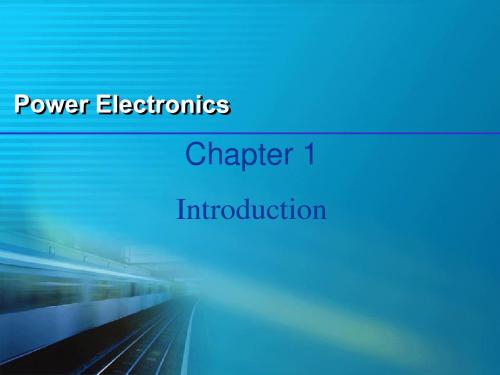
II.
The history
Application of fast-switching Invention of fully-controlled Thyristor semiconductor devices GTO GTR Mercury arc rectifier Power MOSFET Power diode Vacuum-tube rectifier Thyristor Thyristor Thyratron (microprocessor)
Other applications
14
Industrial applications
Motor drives
Electrolysis
Electroplating
Induction heating
Power
Welding Arc furnaces and ovens Lighting
15
Transportation applications
13
III. Applications
Industrial Transportation Utility systems
Power supplies for all kinds of electronic equipment
Power
Residential and home appliances
Space technology
Power electronics: to process electric power
Other classifications of electronics
Power
Electronics
Vacuum electronics: using vacuum devices, e.g, vacuum tubes devices Solid (Solid state) electronics: using solid state devices, e.g, semiconductor devices Physical electronics: physics,material,fabrication, and manufacturing of electronic devices Applied electronics: application of electronic devices to various areas 9
电力电子技术王兆安第五版第一章英文课件
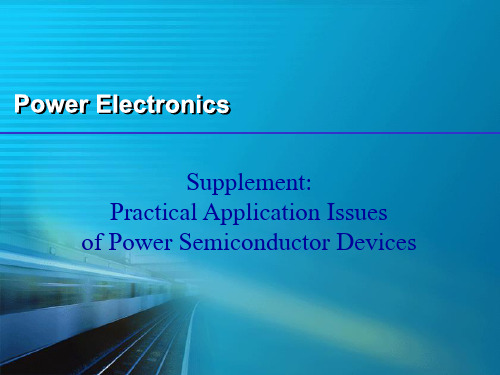
Power
V2关断而V3开通 时输入出负脉冲
图1-29 典型的直接耦合式GTO驱动电路
V3关断后电阻R3和R4 提供门极负偏压
11
1.7 Protection of power semiconductor devices
Protection circuits Overvoltage protection Overcurrent protection Snubber circuits—specific protection circuits that circuits— can limit du/dt or di/dt TurnTurn-on snubber TurnTurn-off snubber
Supplement: Practical Application Issues of Power Semiconductor Devices
Outline
Practical application issues of power semiconductor devices Gate drive circuit (Section 1.6 in the Chinese textbook) Protection of power semiconductor devices (Section 1.7 in the Chinese textbook) Series and parallel connections of power semiconductor devices (Section 1.8 in the Chinese textbook)
G
O
t
5V的负偏压
Power
iG O
正的门极电流
t
图1-28 推荐的GTO门极电压电流波形
《电力电子技术》PPT课件

可控硅时代
通过控制电流导通角,实现电 压和功率的调节。
现代电力电子时代
以IGBT、MOSFET等为代表 ,实现高效、快速的电能转换
。
电力电子技术的应用领域
电力系统
用于高压直流输电、无 功补偿、有源滤波等, 提高电力系统的稳定性
和效率。
电机驱动
用于电动汽车、电动自 行车、电梯等电机驱动 系统,实现高效、节能
照明控制
通过电力电子技术可实现 对照明设备的调光和调色 ,提高照明质量和节能效 果。
加热与焊接
电力电子技术可用于控制 加热设备的功率和温度, 实现精确控温和高效能焊 接。
交通运输应用
电动汽车驱动
电力电子技术是电动汽车 驱动系统的核心,可实现 高效能、低排放的驱动控 制。
轨道交通牵引
通过电力电子技术可实现 轨道交通车辆的牵引控制 和制动能量回收。
交流-交流变流电路的工作原理
通过电力电子器件的开关作用,改变输入交流电 的电压和频率,得到所需的输出交流电。Fra bibliotekABCD
交流-交流变流电路的分类
变频电路、变压电路等。
交流-交流变流电路的应用
电机调速、风力发电、太阳能发电并网等。
一般工业应用
01
02
03
电机驱动
电力电子技术可用于控制 电机的速度和转矩,提高 电机的效率和性能。
通过求解系统微分方程或差分方程,得到系统输 出与输入之间的关系,进而分析系统性能。
频域分析法
利用傅里叶变换将时域信号转换为频域信号,通 过分析系统频率响应特性来评估系统性能。
3
状态空间分析法
通过建立系统状态空间模型,分析系统状态变量 的变化规律,从而研究系统的稳定性和动态性能 。
电力电子双语教学课件
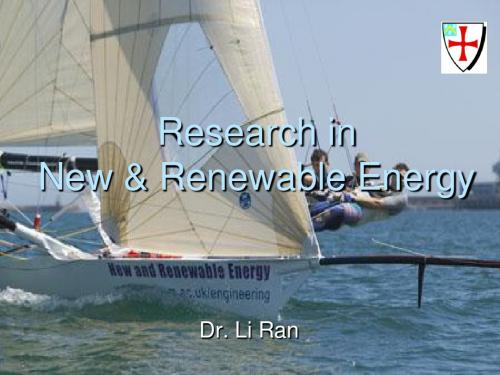
Dr. Li Ran
Wind Power
Recent Studies in Wind Power
Grid
Doubly Fed Induction Generator
Gearbox
Filter
Wind Turbine
4Q Converter
Converter design: system simulation250.0Fra bibliotek200.0
Electrical power (W)
150.0
100.0
50.0
0.0 2 3 4 5 6 7 8 9 10 Wind speed (m/s) Maximum power Battery connection
Durham 30 kW DFIG Test Rig
XPC Targetbox 4Q conv real time system
Grid VARIAC Filter
DFIG
prime drive with programmable direct torque control
Laboratory verification
wind farm registered capacity
voltage during fault 0% 15% <30 MW July 2005 January 2004 >=30 MW January 2004 before January 2004
● The voltage refers to that on the transmission system (275 or 132 kV). Transformer impedance and fault infeed from the wind farm are likely to result in a higher voltage at generator terminal. ● Fault is cleared in 140 ms for 132 kV and 100 ms for 275 kV system. Backup clearance time can extend to 300 ms.
电力电子技术ppt课件
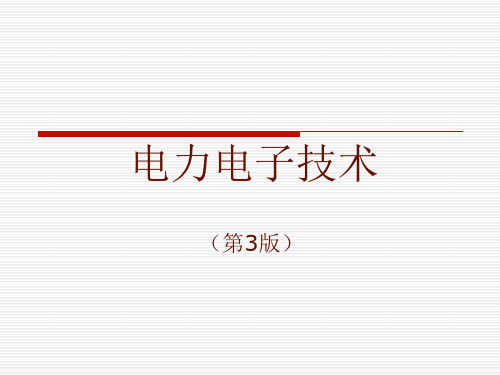
② 按照内部载流子的工作性质分: 单极型器件:导通时只有空穴或电子一种载流子导电的器件。功率场
效应晶体管,器件的特点主要是工作频率高、导通压降较大,单个器 件容量较小。 双极型器件:导通时的载流子既有空穴也有电子导电的器件。功率二 极管、晶闸管及派生器件、可关断晶闸管、双极型功率晶体管等。器 件的特点主要是功率较高、而工作频率较低。 复合型器件:复合型既含有单极型器件的结构,又有双极型器件的结 构,通常其控制部分采用单极性结构,主功率部分采用双极型结构。 绝缘栅双极型晶体管、MOS控制晶闸管等。结合了两者的优点,具有 卓越的电气性能,是电力电子器件的发展方向。
电力电子技术
(第3版)
绪论
1. 电力电子技术的内容 2. 电力电子技术的发展 3. 电力电子技术的应用 4. 电力电子技术课程的学习要求
1. 电力电子技术的内容
电力电子学 , 又 称 功 率 电 子 学 (Power Electronics)。它主要 研究各种电力电子器件,以及由 这些电力电子器件所构成的各式 各样的电路或装置,以完成对电 能的变换和控制。
4. 电力电子技术课程的学习要求
熟悉和掌握常用电力电子器件的工作机理、特性和参数,能正确选 择和使用它们。
熟悉和掌握各种基本变换器的工作原理,特别是各种基本电路中的 电磁过程,掌握其分析方法、工作波形分析和变换器电路的初步设 计计算。
了解各种开关元件的控制电路、缓冲电路和保护电路。 了解各种变换器的特点、性能指标和使用场合。 掌握基本实验方法与训练基本实验技能。
电力电子器件的电压、电流、开关频率是影响它们使用的关键参数 ➢电压容量从低到高的顺序依次为功率场效应晶体管、绝缘栅双极型晶体 管、双极型功率晶体管、可关断晶闸管、晶闸管,其中绝缘栅双极型晶 体管、双极型功率晶体管电压容量接近,可关断晶闸管、晶闸管电压容 量接近。 ➢电流容量从低到高的顺序依次为功率场效应晶体管、绝缘栅双极型晶体 管、双极型功率晶体管、可关断晶闸管、晶闸管,其中绝缘栅双极型晶 体管、双极型功率晶体管电流容量接近。 ➢开关频率从低到高的顺序依次为晶闸管、可关断晶闸管、双极型功率晶 体管、绝缘栅双极型晶体管、功率场效应晶体管,其中绝缘栅双极型晶 体管、双极型功率晶体管的开关频率接近。
外文翻译—电力电子技术(英文+译文)
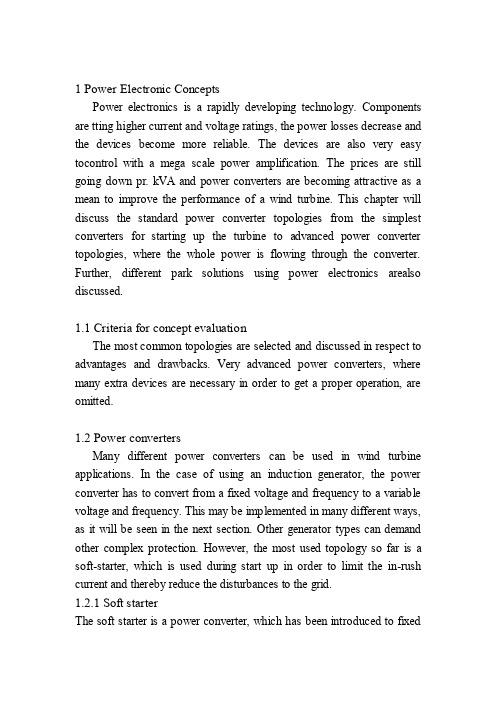
1 Power Electronic ConceptsPower electronics is a rapidly developing technology. Components are tting higher current and voltage ratings, the power losses decrease and the devices become more reliable. The devices are also very easy tocontrol with a mega scale power amplification. The prices are still going down pr. kVA and power converters are becoming attractive as a mean to improve the performance of a wind turbine. This chapter will discuss the standard power converter topologies from the simplest converters for starting up the turbine to advanced power converter topologies, where the whole power is flowing through the converter. Further, different park solutions using power electronics arealso discussed.1.1 Criteria for concept evaluationThe most common topologies are selected and discussed in respect to advantages and drawbacks. Very advanced power converters, where many extra devices are necessary in order to get a proper operation, are omitted.1.2 Power convertersMany different power converters can be used in wind turbine applications. In the case of using an induction generator, the power converter has to convert from a fixed voltage and frequency to a variable voltage and frequency. This may be implemented in many different ways, as it will be seen in the next section. Other generator types can demand other complex protection. However, the most used topology so far is a soft-starter, which is used during start up in order to limit the in-rush current and thereby reduce the disturbances to the grid.1.2.1 Soft starterThe soft starter is a power converter, which has been introduced to fixedspeed wind turbines to reduce the transient current during connection or disconnection of the generator to the grid. When the generator speed exceeds the synchronous speed, the soft-starter is connected. Using firing angle control of the thyristors in the soft starter the generator is smoothly connected to the grid over a predefined number of grid periods. An example of connection diagram for the softstarter with a generator is presented in Figure1.Figure 1. Connection diagram of soft starter with generators.The commutating devices are two thyristors for each phase. These are connected in anti-parallel. The relationship between the firing angle (﹤) and the resulting amplification of the soft starter is non-linear and depends additionally on the power factor of the connected element. In the case of a resistive load, may vary between 0 (full on) and 90 (full off) degrees, in the case of a purely inductive load between 90 (full on) and 180 (full off) degrees. For any power factor between 0 and 90 degrees, w ill be somewhere between the limits sketched in Figure 2.Figure 2. Control characteristic for a fully controlled soft starter.When the generator is completely connected to the grid a contactor (Kbyp) bypass the soft-starter in order to reduce the losses during normal operation. The soft-starter is very cheap and it is a standard converter in many wind turbines.1.2.2 Capacitor bankFor the power factor compensation of the reactive power in the generator, AC capacitor banks are used, as shown in Figure 3. The generators are normally compensated into whole power range. The switching of capacitors is done as a function of the average value of measured reactive power during a certain period.Figure 3. Capacitor bank configuration for power factor compensation ina wind turbine.The capacitor banks are usually mounted in the bottom of the tower or in thenacelle. In order to reduce the current at connection/disconnection of capacitors a coil (L) can be connected in series. The capacitors may be heavy loaded and damaged in the case of over-voltages to the grid and thereby they may increase the maintenance cost.1.2.3 Diode rectifierThe diode rectifier is the most common used topology in power electronic applications. For a three-phase system it consists of six diodes. It is shown in Figure 4.Figure 4. Diode rectifier for three-phase ac/dc conversionThe diode rectifier can only be used in one quadrant, it is simple and it is notpossible to control it. It could be used in some applications with a dc-bus.1.2.4 The back-to-back PWM-VSIThe back-to-back PWM-VSI is a bi-directional power converter consisting of two conventional PWM-VSI. The topology is shown in Figure 5.To achieve full control of the grid current, the DC-link voltage must be boosted to a level higher than the amplitude of the grid line-line voltage. The power flow of the grid side converter is controlled in orderto keep the DC-link voltage constant, while the control of the generator side is set to suit the magnetization demand and the reference speed. The control of the back-to-back PWM-VSI in the wind turbine application is described in several papers (Bogalecka, 1993), (Knowles-Spittle et al., 1998), (Pena et al., 1996), (Yifan & Longya, 1992), (Yifan & Longya, 1995).Figure 5. The back-to-back PWM-VSI converter topology.1.2.4.1 Advantages related to the use of the back-to-back PWM-VSIThe PWM-VSI is the most frequently used three-phase frequency converter. As a consequence of this, the knowledge available in the field is extensive and well established. The literature and the available documentation exceed that for any of the other converters considered in this survey. Furthermore, many manufacturers produce components especially designed for use in this type of converter (e.g., a transistor-pack comprising six bridge coupled transistors and anti paralleled diodes). Due to this, the component costs can be low compared to converters requiring components designed for a niche production.A technical advantage of the PWM-VSI is the capacitor decoupling between the grid inverter and the generator inverter. Besides affording some protection, this decoupling offers separate control of the two inverters, allowing compensation of asymmetry both on the generator side and on the grid side, independently.The inclusion of a boost inductance in the DC-link circuit increases the component count, but a positive effect is that the boost inductance reduces the demands on the performance of the grid side harmonic filter, and offers some protection of the converter against abnormal conditions on the grid.1.2.4.2 Disadvantages of applying the back-to-back PWM-VSIThis section highlights some of the reported disadvantages of the back-to-back PWM-VSI which justify the search for a more suitable alternative converter:In several papers concerning adjustable speed drives, the presence of the DC link capacitor is mentioned as a drawback, since it is heavy and bulky, it increases the costs and maybe of most importance, - it reduces the overall lifetime of the system. (Wen-Song & Ying-Yu, 1998); (Kim & Sul, 1993); (Siyoung Kim et al., 1998).Another important drawback of the back-to-back PWM-VSI is the switching losses. Every commutation in both the grid inverter and the generator inverter between the upper and lower DC-link branch is associated with a hard switching and a natural commutation. Since the back-to-back PWM-VSI consists of two inverters, the switching losses might be even more pronounced. The high switching speed to the grid may also require extra EMI-filters.To prevent high stresses on the generator insulation and to avoid bearing current problems (Salo & Tuusa, 1999), the voltage gradient may have to be limited by applying an output filter.1.2.5 Tandem converterThe tandem converter is quite a new topology and a few papers only have treated it up till now ((Marques & Verdelho, 1998); (Trzynadlowski et al., 1998a); (Trzynadlowski et al., 1998b)). However, the idea behind the converter is similar to those presented in ((Zhang et al., 1998b)), where the PWM-VSI is used as an active harmonic filter to compensate harmonic distortion. The topology of the tandem converter is shown inFigure 6.Figure 6. The tandem converter topology used in an induction generator wind turbine system.The tandem converter consists of a current source converter, CSC, in thefollowing designated the primary converter, and a back-to-back PWM-VSI, designated the secondary converter. Since the tandem converter consists of four controllable inverters, several degrees of freedom exist which enable sinusoidal input and sinusoidal output currents. However, in this context it is believed that the most advantageous control of the inverters is to control the primary converter to operate in square-wave current mode. Here, the switches in the CSC are turned on and off only once per fundamental period of the input- and output current respectively. In square wave current mode, the switches in the primary converter may either be GTO.s, or a series connection of an IGBT and a diode.Unlike the primary converter, the secondary converter has to operateat a high switching frequency, but the switched current is only a small fraction of the total load current. Figure 7 illustrates the current waveform for the primary converter, the secondary converter, is, and the total load current il.In order to achieve full control of the current to/from the back-to-back PWMVSI, the DC-link voltage is boosted to a level above the grid voltage. As mentioned, the control of the tandem converter is treated in only a few papers. However, the independent control of the CSC and the back-to-back PWM-VSI are both well established, (Mutschler & Meinhardt, 1998); (Nikolic & Jeftenic, 1998); (Salo & Tuusa, 1997); (Salo & Tuusa, 1999).Figure 7. Current waveform for the primary converter, ip, the secondary converter, is, and the total load current il.1.2.5.1Advantages in the use of the Tandem ConverterThe investigation of new converter topologies is commonly justifiedby thesearch for higher converter efficiency. Advantages of the tandem converter are the low switching frequency of the primary converter, and the low level of the switched current in the secondary converter. It is stated that the switching losses of a tandem inverter may be reduced by 70%, (Trzynadlowski et al., 1998a) in comparison with those of an equivalent VSI, and even though the conduction losses are higher for the tandem converter, the overall converter efficiency may be increased.Compared to the CSI, the voltage across the terminals of the tandem converter contains no voltage spikes since the DC-link capacitor of the secondary converter is always connected between each pair of input- and output lines (Trzynadlowski et al., 1998b).Concerning the dynamic properties, (Trzynadlowski et al., 1998a) states that the overall performance of the tandem converter is superior to both the CSC and the VSI. This is because current magnitude commands are handled by the voltage source converter, while phase-shift current commands are handled by the current source converter (Zhang et al., 1998b).Besides the main function, which is to compensate the current distortion introduced by the primary converter, the secondary converter may also act like an active resistor, providing damping of the primary inverter in light load conditions (Zhang et al., 1998b).1.2.5.2 Disadvantages of using the Tandem ConverterAn inherent obstacle to applying the tandem converter is the high number of components and sensors required. This increases the costs and complexity of both hardware and software. The complexity is justified by the redundancy of the system (Trzynadlowski et al., 1998a), however the system is only truly redundant if a reduction in power capability and performance is acceptable.Since the voltage across the generator terminals is set by the secondary inverter, the voltage stresses at the converter are high.Therefore the demands on the output filter are comparable to those when applying the back-to-back PWM-VSI.In the system shown in Figure 38, a problem for the tandem converter in comparison with the back-to-back PWM-VSI is the reduced generator voltage. By applying the CSI as the primary converter, only 0.866% of the grid voltage can be utilized. This means that the generator currents (and also the current through the switches) for the tandem converter must be higher in order to achieve the same power.1.2.6 Matrix converterIdeally, the matrix converter should be an all silicon solution with no passive components in the power circuit. The ideal conventional matrix converter topology is shown in Figure 8.Figure 8. The conventional matrix converter topology.The basic idea of the matrix converter is that a desired input current (to/from the supply), a desired output voltage and a desired output frequency may be obtained by properly connecting the output terminals of the converter to the input terminals of the converter. In order to protect the converter, the following two control rules must be complied with: Two (or three) switches in an output leg are never allowed to be on at the same time. All of the three output phases must be connected to an input phase at any instant of time. The actual combination of the switchesdepends on the modulation strategy.1.2.6.1 Advantages of using the Matrix ConverterThis section summarises some of the advantages of using the matrix converter in the control of an induction wind turbine generator. For a low output frequency of the converter the thermal stresses of the semiconductors in a conventional inverter are higher than those in a matrix converter. This arises from the fact that the semiconductors in a matrix converter are equally stressed, at least during every period of the grid voltage, while the period for the conventional inverter equals the output frequency. This reduces thethermal design problems for the matrix converter.Although the matrix converter includes six additional power switches compared to the back-to-back PWM-VSI, the absence of the DC-link capacitor may increase the efficiency and the lifetime for the converter (Schuster, 1998). Depending on the realization of the bi-directional switches, the switching losses of the matrix inverter may be less than those of the PWM-VSI, because the half of the switchings become natural commutations (soft switchings) (Wheeler & Grant, 1993).1.2.6.2 Disadvantages and problems of the matrix converterA disadvantage of the matrix converter is the intrinsic limitation of the output voltage. Without entering the over-modulation range, the maximum output voltage of the matrix converter is 0.866 times the input voltage. To achieve the same output power as the back-to-back PWM-VSI, the output current of the matrix converter has to be 1.15 times higher, giving rise to higher conducting losses in the converter (Wheeler & Grant, 1993).In many of the papers concerning the matrix converter, the unavailability of a true bi-directional switch is mentioned as one of the major obstacles for the propagation of the matrix converter. In the literature, three proposals for realizing a bi-directional switch exists. The diode embedded switch (Neft & Schauder, 1988) which acts like a truebi-directional switch, the common emitter switch and the common collector switch (Beasant et al., 1989).Since real switches do not have infinitesimal switching times (which is not desirable either) the commutation between two input phases constitutes a contradiction between the two basic control rules of the matrix converter. In the literature at least six different commutation strategies are reported, (Beasant et al., 1990); (Burany, 1989); (Jung & Gyu, 1991); (Hey et al., 1995); (Kwon et al., 1998); (Neft & Schauder, 1988). The most simple of the commutation strategies are those reported in (Beasant et al., 1990) and (Neft & Schauder, 1988), but neither of these strategies complies with the basic control rules.译文1 电力电子技术的内容电力电子技术是一门正在快速发展的技术,电力电子元器件有很高的额定电流和额定电压,它的功率减小元件变得更加可靠、耐用.这种元件还可以用来控制比它功率大很多倍的元件。
电力电子技术新书课件第一章课件,张兴

电
力
电
子
技
术
1.2 电力电子技术的发展史
■电力电子技术的发展史
图1.3 电力电子技术的发展史
◆一般认为,电力电子技术的诞生是以1957年美国通用 一般认为,电力电子技术的诞生是以 年 电气公司研制出第一个晶闸管为标志的。 晶闸管为标志的 电气公司研制出第一个晶闸管为标志的。
电
力
电
子
技
术
1.2 电力电子技术的发展
电力电子技术起始于20世纪50年代末20世纪60年代初的 硅整流器件,其发展经历了以低频技术为主的传统电力电 子技术时期和以高频技术为主的现代电力电子技术时期 在20世纪80年代末期和20世纪90年代初期以IGBT 和功率 MOSFET为代表发展起来的集高频、高压和大电流于一身 的功率半导体复合器件,表明传统电力电子技术已经进入 现代电力电子时代 进入20世纪90年代以来,电力电子技术进入了一个崭新的 快速发展时期。理论分析和实验表明:电力电子产品体积 与重量的缩小与供电频率的平方根成反比,因此电力电子 技术高频化是今后电力电子技术创新与发展的主导方向
电
力
电
子
技
术
1.2 电力电子技术的发展
近年来,随着能源危机的出现,电力电子技术技术在变频 调速、新能源发电等方面得到了快速发展,世界各国对电 力电子技术也更加重视 一方面具有自关断能力的大功率高频新器件及其应用技术 取得了惊人的进步;另一方面,同微电子技术紧密结合的 新一代智能化功率集成电力电子技术初露锋芒 展望未来,随着具有高可靠性的集成电力电子模块 IPEM(Integrated Power Electronic Modules)技术以及具 有导通损耗小,耐压高、高结温等的特点的Silicon(硅)等 新一代宽禁带器件的应用将会使电力电子技术发生新一轮 革命性的变化
2024版电力电子技术完整版全套PPT电子课件
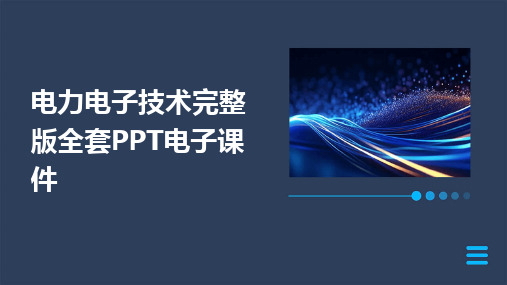
contents•电力电子技术概述•电力电子器件目录•电力电子电路•电力电子技术的控制策略•电力电子技术的实验与仿真电力电子技术的定义与发展定义发展历程如太阳能、风能等可再生能源的转换与利用。
如电动汽车、电动自行车等电机驱动系统的控制。
如智能电网、分布式发电等电力系统的优化与控制。
如变频器、伺服系统等工业自动化设备的控制。
能源转换电机驱动电力系统工业自动化高效率、高功率密度智能化、数字化绿色化、环保化多学科交叉融合晶闸管(Thyristor 可控的单向导电性,用于可控整流电路Power Diode )具有单向导电性,可用于整流电路010402050306电力晶体管(Giant Transistor,GTR)具有耐压高、电流大、开关特性好等优点通过在门极施加负脉冲使其关断电流控制型器件,通过控制基极电流来控制集电极电流可关断晶闸管(Gate Turn-OffThyristor,GTO)具有可控的开关特性,适用于高电压、大电流场合01电力场效应晶体管(Power MOSFET )02电压控制型器件,通过控制栅源电压来控制漏极电流03具有开关速度快、输入阻抗高、热稳定性好等优点04绝缘栅双极型晶体管(Insulated Gate Bipolar Transistor ,IGBT )05结合了MOSFET 和GTR 的优点,具有电压控制、大电流、低饱和压降等特性06广泛应用于电机控制、电源转换等领域整流电路整流电路的工作原理介绍整流电路的基本工作原理,包括半波整流、全波整流和桥式整流等。
整流电路的类型详细阐述不同类型的整流电路,如单相半波整流电路、单相全波整流电路、三相半波整流电路和三相全波整流电路等。
整流电路的应用列举整流电路在电力电子领域的应用,如电源供应器、电池充电器和电机驱动器等。
逆变电路逆变电路的工作原理01逆变电路的类型02逆变电路的应用031 2 3直流-直流变流电路的工作原理直流-直流变流电路的类型直流-直流变流电路的应用交流-交流变流电路的工作原理01交流-交流变流电路的类型02交流-交流变流电路的应用03电动机控制电热控制照明控制030201一般工业应用交通运输应用电动汽车驱动轨道交通牵引飞机电源系统电力系统应用高压直流输电柔性交流输电分布式发电与微电网新能源应用风能发电太阳能发电风力发电机组中采用电力电子技术实现变速恒频控制,提高风能发电的稳定性和可靠性。
电气考研:电力电子课程英文版

The concept of power electronic devices
Power electronic devices:
are the electronic devices that can be directly used in the power processing circuits to convert or control electric power.
electronic devices
3
1.1 An introductory overview of power electronic devices
The concept and features Configuration of systems using power
electronic devices Classifications Major topics
A power electronic device usually has a third terminal —— control terminal to control the states of the device.
A power electronic device must have at least two terminals to allow power circuit current flow through.
12
Major topics for each device
Appearance, structure, and symbol Physics of operation
Characteristics
Static characteristics Switching characteristics
电力电子技术Power Electronics 22页PPT文档

1.1 电力电子与信息电子
电子技术
电力电子器件制造技术
信息电子技术
电力电子技术
目前电力电子器件均用半导体 制成,故也称电力半导体器件。
模拟电子技术 数字电子技术
变流技术 !!!
信息电子技术——信息处理 电力电子技术——电力变换
电力电子技术(定义):使用电力
用电力电子器件构成电力变换 电路和对其进行控制的技术, 以及构成电力电子装置和电力 电子系统的技术。
微型计算机
3 电力电子技术的应用
5)家用电器
docin/sundae_meng
3 电力电子技术的应用
6)其他
大型计算机的UPS
新型能源
docin/sundae_meng
航天技术
4 教材的内容简介和使用说明 4.1 教材的内容简介 4.2 教材的使用说明
docin/sundae_meng
4.1 教材的内容简介
电力电子技术 Power Electronics
docin/sundae_meng
绪论
1 什么是电力电子技术 2 电力电子技术的发展史 3 电力电子技术的应用 4 教材内容简介和使用说明
docin/sundae_meng
1 什么是电力电子技术
1.1 电力电子与信息电子 1.2 两大分支 1.3 与其他学科的关系 1.4 地位和未来
电子器件对电能进行变换和控制 的技术,即:应用于电力领域的 电子技术。
电力电子技术变换的“电力”, 可大到数百MW甚至GW,也 可小到数W甚至mW级。
docin/sundae_meng
1.2 两大分支
变流技术
电力电子器件 电力电子变流技术
电力电子技术双语课件第3-4章
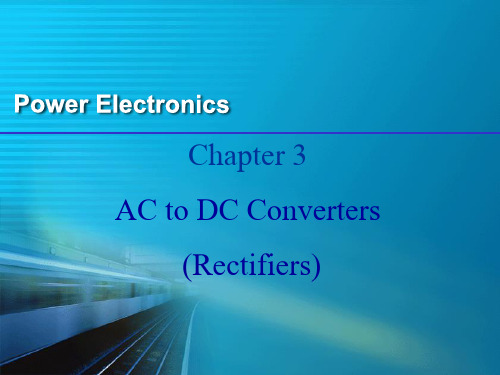
VT
VT
Power
L
L
u2
u2
R
R
a)
b)
L did dt
Rid
2U2 sin t
(3-2)
ωt = ,id= 0
id
2U 2
sin(
R (t )
)e L
Z
2U2 sin(t ) Z
(3-3)
6
Single-phase half-wave controlled
rectifier with freewheeling diode
2 d
d
(t
)
2 Id
(3-7)
O uVT
t
g)
IVDR
1 2
2
Id2d (t)
2
Id
(3-8)
O
t
Maximum forward voltage, maximum reverse voltage
Disadvantages:
– Only single pulse in one line cycle
The time-domain behavior of a power electronic
circuit is actually the combination of consecutive
transients of the different linear circuits when the
power semiconductor devices are in different states.
VT3
VT1
Power
T i2 a
u1
u2
b
L ud
